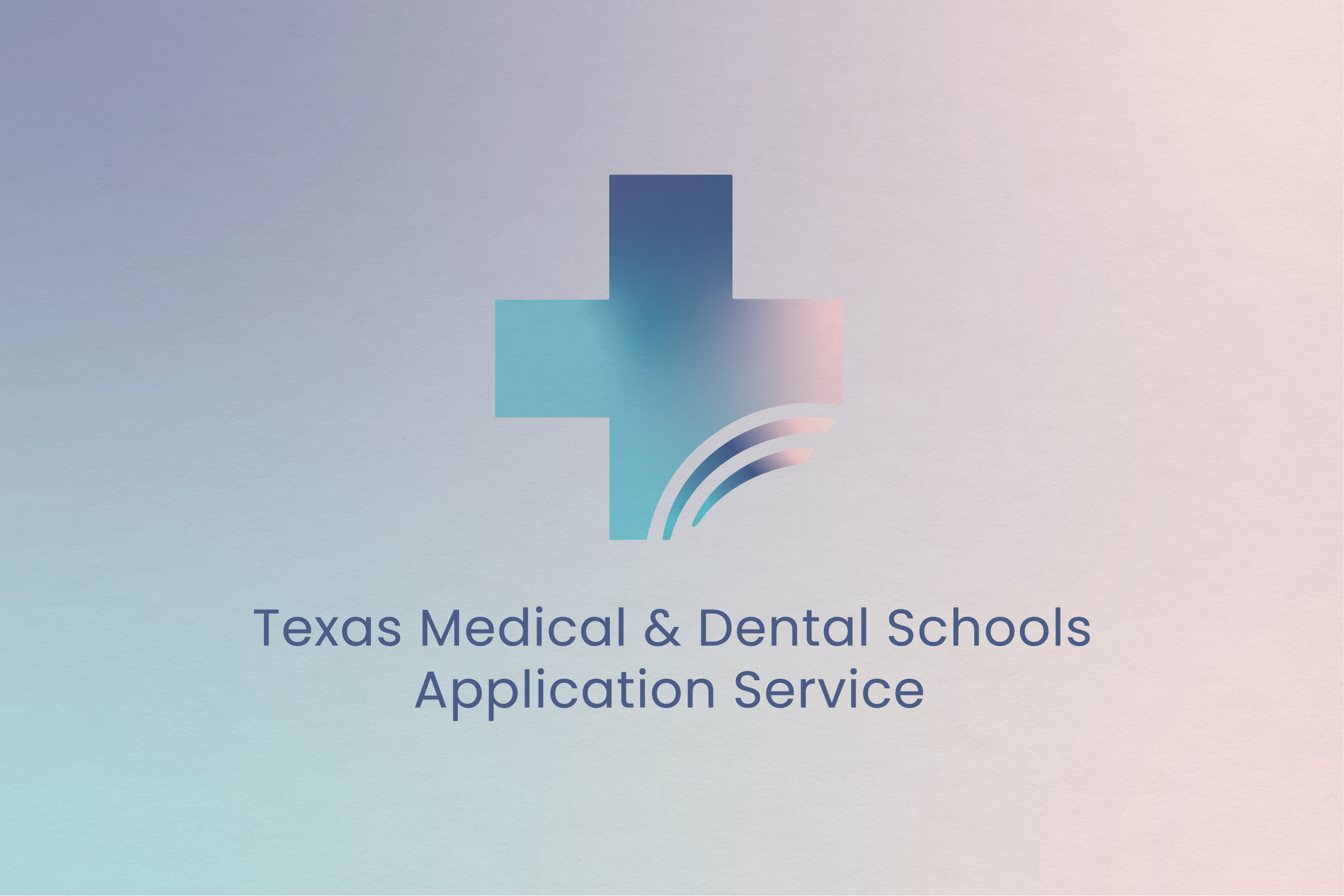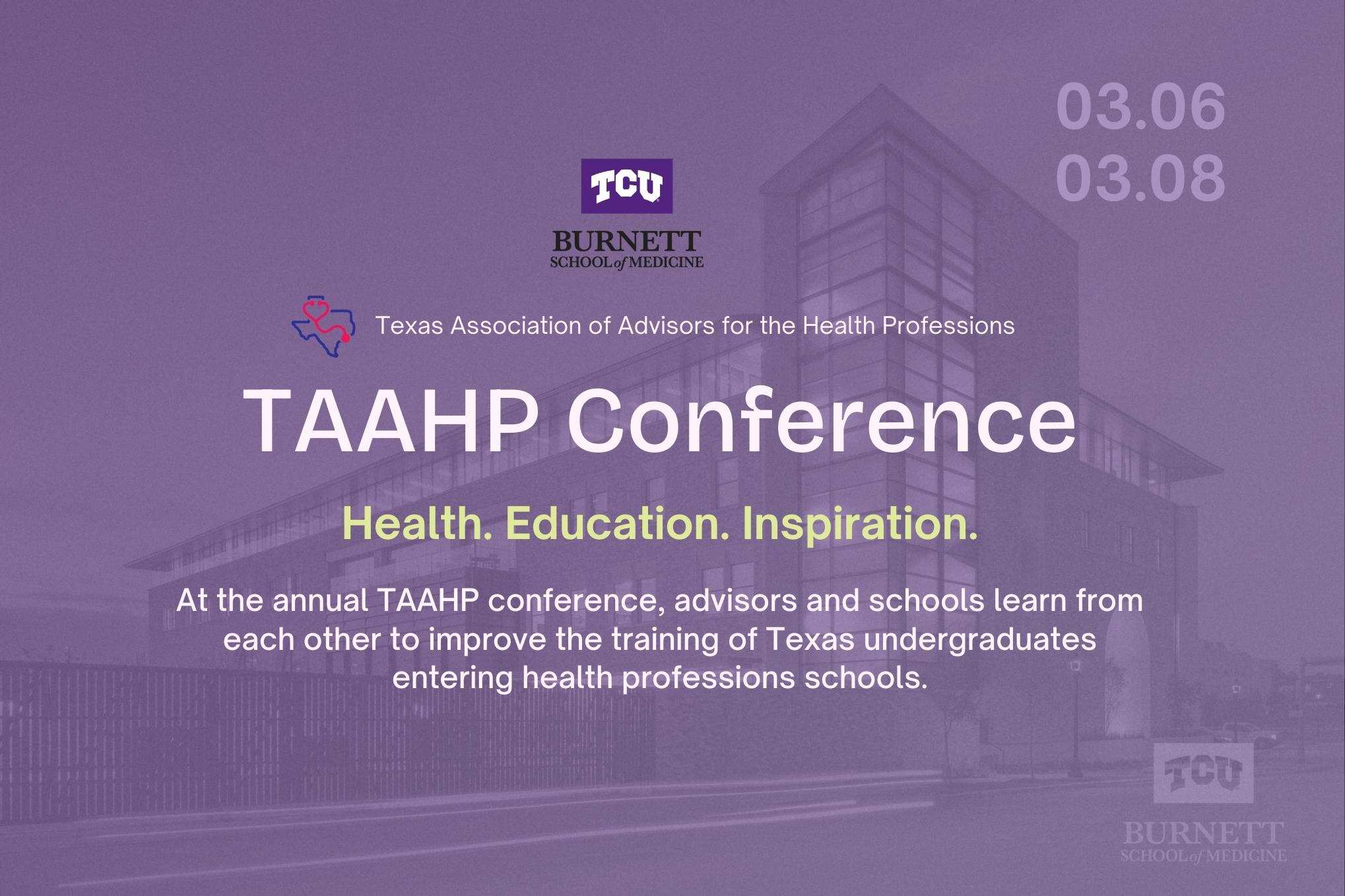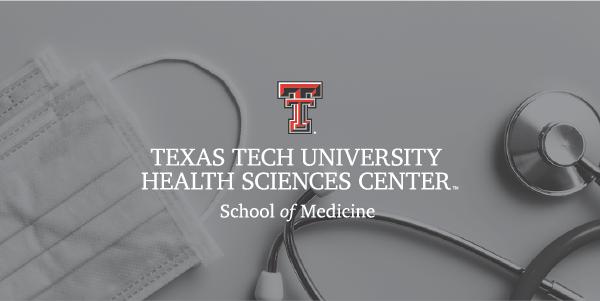EY 2021 Applicant Survey
TMDSAS surveyed 9,367 individuals who completed and submitted an EY 2021 application
about their applicant experience.
What: The survey consisted of 73 questions, covering the following topics: Communication,
Application Strategy/Preparation, Application Resources, Application Usability, TMDSAS
Support Features, and Self-Identifying questions.
Who: The survey was sent to the 9,367 applicants and was completed by 549 (approx. 6%)
of the applicant pool.
When: The survey window was from March 24 to April 13, 2021
How: The applicant survey was sent via email.
Why: The purpose of the survey was to learn the ways in which TMDSAS applicants are using
TMDSAS as an application service, to test our assumptions about the ways applicants
interact with the various resources provided by TMDSAS, and to improve the sphere
and efficacy of these resources. For this survey, particular emphasis was also placed
on learning how applicants prepare for the application process by engaging with outreach
and educational components.
What We Learned
The EY 2021 survey brought with it important lessons about the way applicants prepare
for their application, specifically how often they engage in activities meant to get
them ready for the process. We learned that over half of respondents indicate not
participating in any kind of pre-application activity at all, which begs the question,
why? We also learned that of those that do participate in these activities, certain
populations turn to some sources more than others. Therefore, the focus becomes ensuring
that applicants receive consistent messaging across all platforms, while also finding
resources that meet their specific needs. The EY 2021 survey also showed us that consistent,
and even persistent, messaging is key to influencing applicant behavior. This has
proven true in the growth in awareness and use of application resources, such as the
Application Guide, as well as the rising practice of printing and reviewing one’s
application prior to submission. Armed with this knowledge, TMDSAS will work to develop
strategies that aim to increase applicant involvement in preparation activities, ensuring
that our diverse applicant pool is well represented, and will continue amplifying
best practices to all audiences.
As TMDSAS works to meet the needs of the pre-health community in Texas, we will continue
to seek feedback from applicants and other key stakeholders to effect organizational
learning and improvement.
1. Preparing for the Application
In recent years, TMDSAS has increased outreach opportunities meant to educate current
and future applicants on best practices for how to complete the TMDSAS application
and navigate the admissions process successfully. These outreach efforts included
in-person application workshops that later transitioned to virtual webinars in 2020
due to constraints brought on by the global pandemic. This shift to online teaching
also created an opportunity for TMDSAS to expand its virtual presence by engaging
with applicants via social media in features such as TMDSAS Office Hours and the TXHES created Courage Sessions series. The aim of these programs was to provide applicants with guidance on specific
aspects of the application and admissions process.
For the EY 2021 Applicant Survey, TMDSAS sought to understand the extent to which
applicants (current and future) made use of these resources and to uncover any potential
correlation between engagement with these resources, applicant background, and overall
success.
TMDSAS also knew that another essential resource for applicants in preparing for application
to professional school is guidance from a pre-health advisor. The survey included
questions regarding access and engagement with a pre-health advisor prior to submission
of a TMDSAS application.
Engagement and Success
Applicants were asked whether or not they had participated in the following activities
prior to submitting their TMDSAS application: met with a pre-health advisor regarding
the application, attended a TMDSAS application workshop (in-person or virtual), and
spoke to a TMDSAS representative at a health professions fair. Applicants were also
able to indicate if they participated in more than one of these activities. We were
surprised to learn that successful applicants - those that had received offers - reported
non-participation at the same rate as the general pool, around 51%.
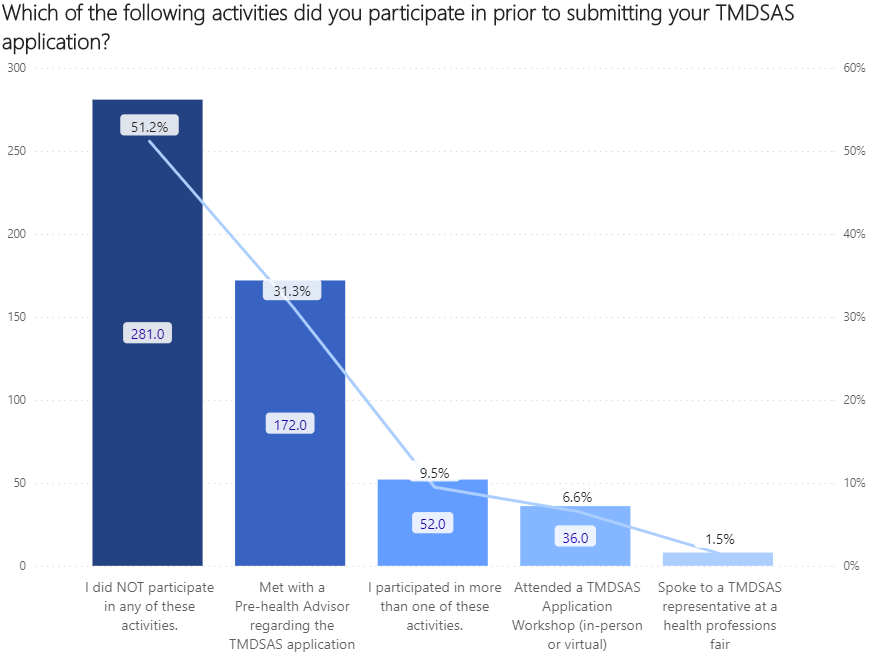
With just over half of our respondents indicating that they did not participate in
any of these activities prior to submitting their TMDSAS application, we looked to
see how members of unique populations reported engaging with these resources.
Texas Residents
We expected to see a difference in the number of applicants participating in these
application preparation activities respective to their residency. We didn’t anticipate
such a disparity.
The percentage of Texas Residents that report not engaging in these activities is
47%.

For non-Texas residents, that number jumps to 68%.

Meeting with a pre-health advisor is the most popular activity reported, however,
regardless of residency status.
As an application service representing Texas schools, it is no surprise that the majority
of our applicants would also be Texas residents. However, the number of non-Texas
residents that apply through TMDSAS has remained steady, at around 22% in recent years.
Therefore, with out-of-state applicants making up such a significant portion of the
applicant pool, TMDSAS would like to see more engagement from non-Texas residents
in activities that prepare them for the application and admissions processes.
Reapplicants
A second unique population is reapplicants. First time applicants report participation
at a comparable rate to their reapplicant counterparts, hovering around 49% and 48%,
respectively. However, did reapplicants and first time applicants engage in the same
activities at the same rate?
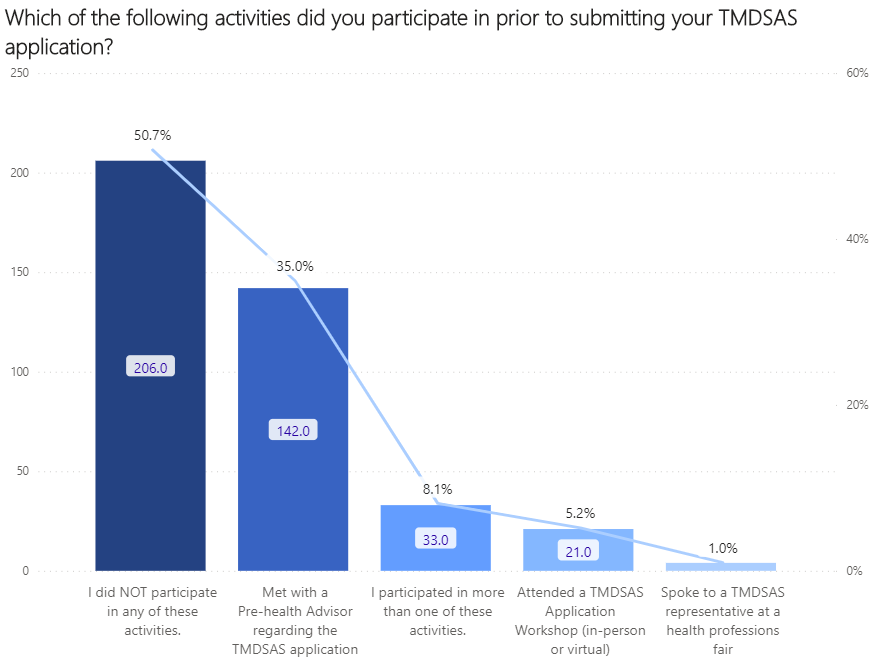
First time applicants reported that by and far, the activity they participated in
most was speaking to a pre-health advisor. However, we start to see a more varied
distribution among the types of activities reapplicants engaged in, with increased
numbers reporting participation in multiple activities such as attending a TMDSAS
application workshop and speaking to a TMDSAS rep at a health professions fair.
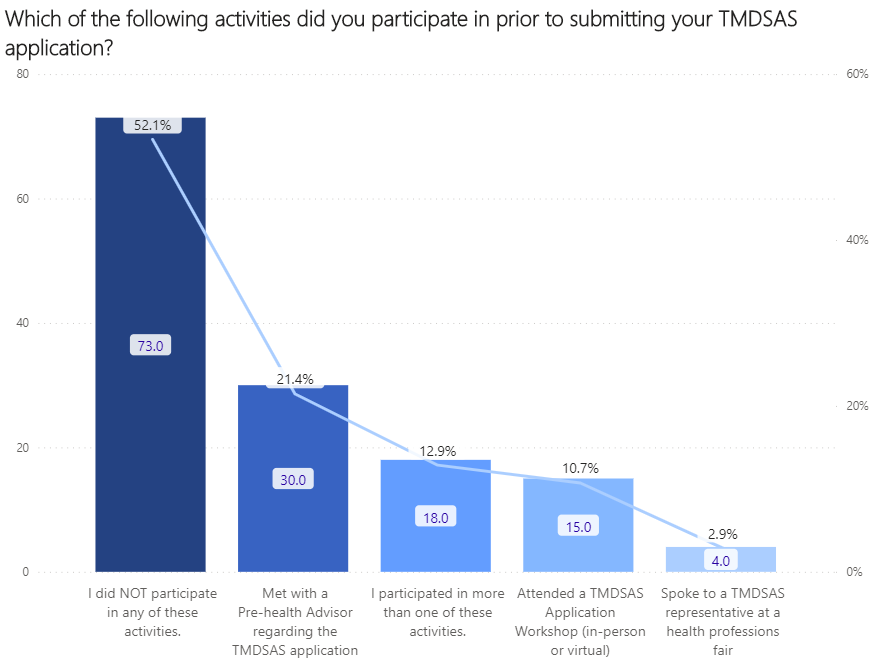
Why might this be? One possible reason for this variation is that reapplicants might
see these activities as opportunities to strengthen a previously unsuccessful application.
This provides a unique opportunity to TMDSAS to create specific resources with reapplicants
in mind. An applicant workshop is a perfect example of an activity that can provide
targeted guidance to reapplicants on making improvements to their application.
Non-Traditional Applicants
A third group that TMDSAS collects data on are applicants that self-identify as “non-traditional”.
What defines “non-traditional” may vary from applicant to applicant; many applicants
that self-identify this way may differ from a traditional applicant demographically
in terms of age, or may already have an established professional career, for example.
The types of resources used by a non-traditional applicant might not match those
typically used by a traditional applicant. Therefore, TMDSAS sought to understand
how non-traditional applicants availed themselves of these resources.
Overall, non-traditional applicants engaged in these activities at a lower rate than
traditional applicants. Non-traditional applicants are also engaging with pre-health
advisors at a lower rate than traditional applicants, likely because they are out
of school and do not have easy access to one.
At the same time, non-traditional applicants report attending a TMDSAS workshop at
a higher rate than traditional applicants. When we slice the data further to look
at successful applicants (those who had received offers of admission at the time of
this survey), we see something even more interesting.

That percentage of successful applicants reporting participation in a TMDSAS workshop
more than doubles for non-traditional applicants.
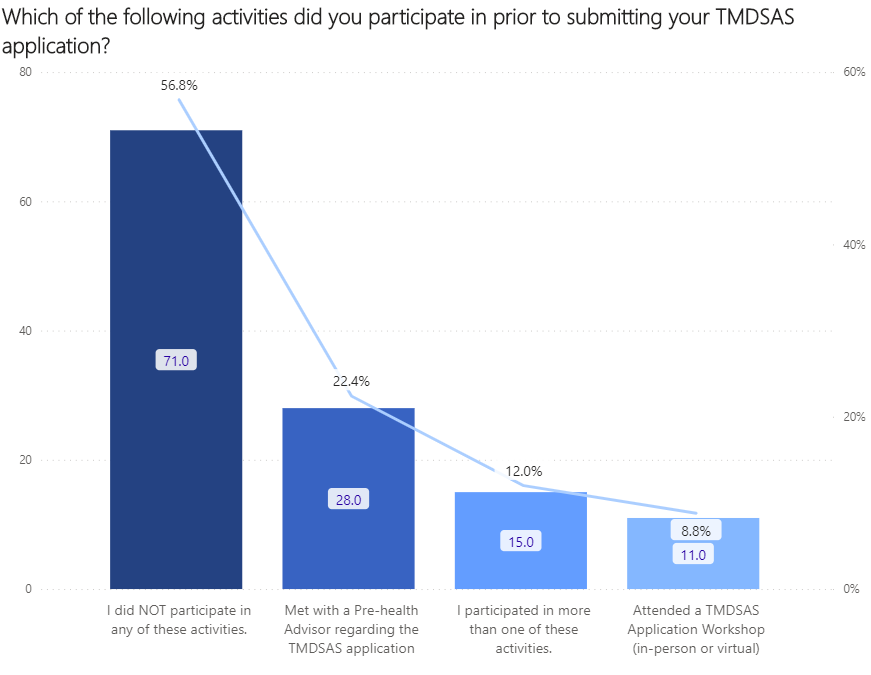
These findings mirror that of reapplicants and underline applicant workshops as a
key component of the educational opportunities provided by TMDSAS.
Greater Confidence
What is the impact that applicants report based on participation in these activities?
Seventy-five percent of applicants that participated in at least one prep activity
report feeling “confident while completing each section of the application”.

If we slice that further and look at applicants who also received offers, the percentage
that report feeling confident is 80%.

Takeaways: We understand that applicants may prepare for their application differently
depending on their background. Certain populations rely more heavily on their pre-health
advisors, especially for Texas residents. However, other groups may not have access
to a pre-health advisor well versed in the TMDSAS application, and this creates an
opportunity for TMDSAS. Firstly, to engage more with pre-health advisors that support
our out-of-state applicants. And secondly, to build upon our virtual workshops as
a way to provide targeted support for applicants from unique populations.
2. Resource Utilization
What about the use of TMDSAS resources? TMDSAS has created a whole host of resources
for applicants to use as they complete their application. These include the Application
Guide, FAQs, Course Listings, TMDSAS Website, and Social Media Pages, to name just
a few. Would there be a connection between resource use and overall prep for the application?
We know that overall, applicants report engaging in pre-application activities at
less than 50%. Did this participation correlate to the way applicants used resources?
It would seem so.

Sixty percent of applicants that engaged in prep activities also report consulting
the Applicant FAQs, Application Guide, and Course Listings at least once. And 62%
report having at least one resource on hand as they worked through the TMDSAS application.
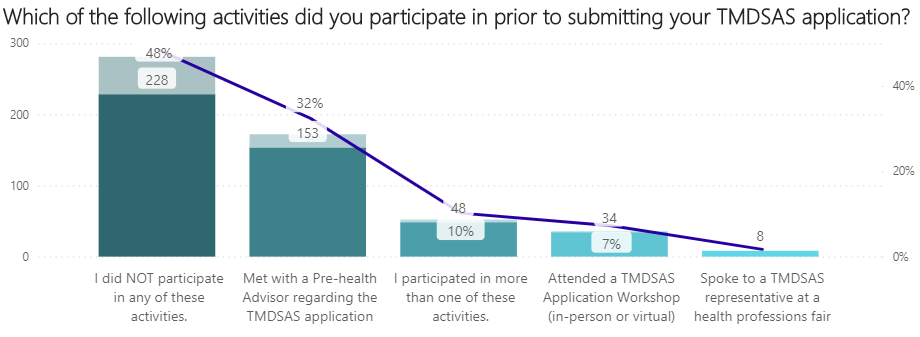
A possible conclusion here is that by meeting with their advisors, speaking to TMDSAS
at a health professions fair, or attending a TMDSAS workshop, applicants are receiving
the message that these resources exist and are heeding the guidance to use them.
Growth with Time
Over the past few years TMDSAS has made a targeted effort to “get the word out” about
these resources and encourage applicants to use them while completing their application.
What has been the result?
We started collecting data on applicants’ reported awareness of resources in EY 2019
and continue to collect this information in our annual applicant survey.
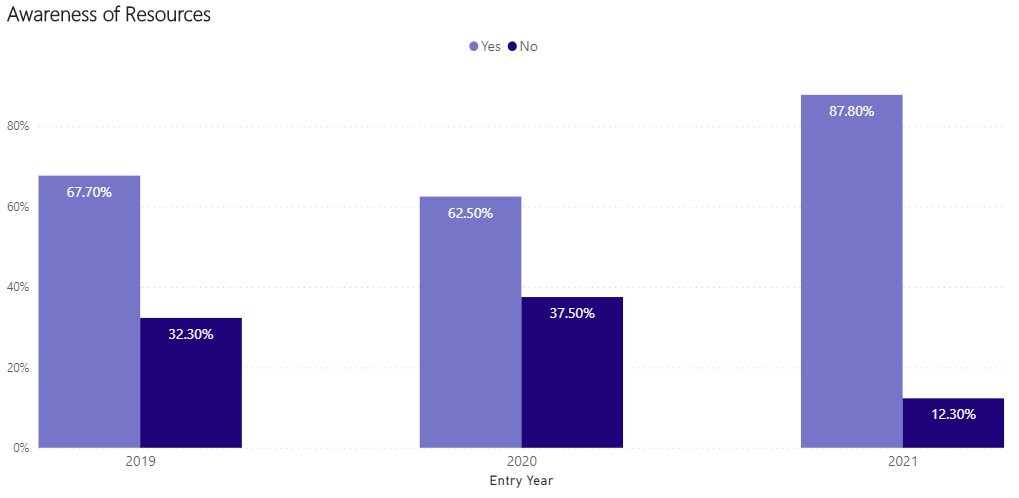
We can see that over the course of three application cycles, applicant awareness of
resources has grown 20%, suggesting that these campaigns have been successful.
One resource in particular that we tend to highlight is the Application Guide which
was created to serve as the step-by-step companion to the application.
How has the use of this resource changed over the course of the three application
cycles?

3. Additional Trends
TMDSAS also collects data on other ways applicants interact with the application itself
or with us as an application service.
Communication
We’ve taken a look at how frequently applicants report communicating with TMDSAS and
for which reasons.
Over the course of three cycles, we see that communication holds steady with an average
of 83% of applicants reporting communicating with us over the three year period with
64% reporting communicating with us 2-5 times.
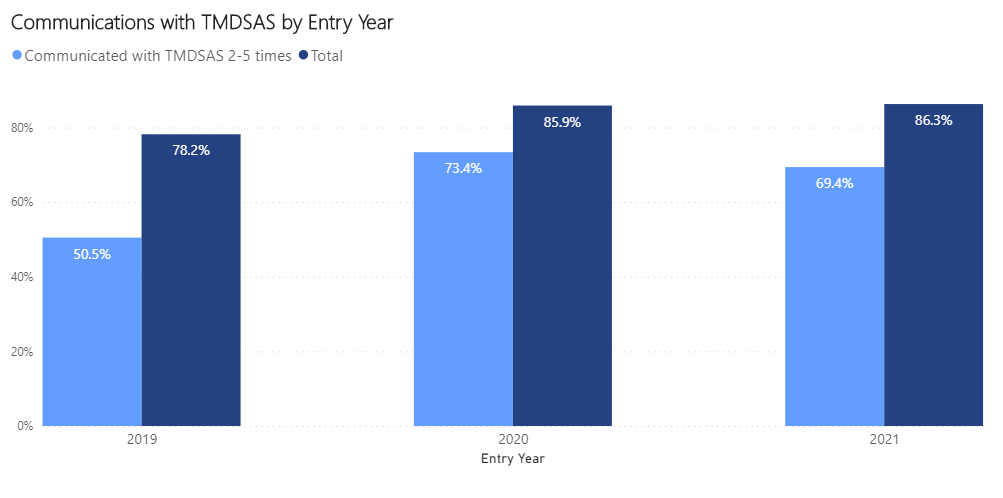
Why do applicants communicate with us? Applicants were asked to select all of the
reasons they communicated with TMDSAS. For the EY 2021 application cycle, these were
the top three:
- Supporting Documents (these include letters of evaluation, transcripts, and test scores):
70%
- Application Help: 58%
- Coursework Questions: 51%
Interestingly, applicants that communicated with TMDSAS for application help also
report having at least one resource on hand at a slightly higher rate than other applicants,
about 3% more as shown in the two images below:
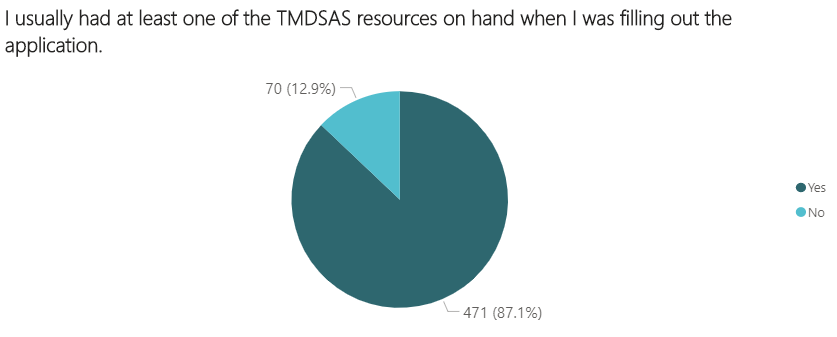
Did applicants have questions that were not addressed in our resources? Or could it
be that applicants were seeking clarification or confirmation of their understanding?

While at the moment the precise answer is yet unknown, TMDSAS is always looking for
ways to improve our resources, so applicant feedback will be key in making future
improvements.
Encouraging Thoroughness
One key message we send to applicants over and over is the need to take their time
and to be thorough when working through the application. When it comes to taking their
time, 58% of applicants report spending more than 10 hours on the application, likely
over the course of multiple sittings.
But how can an applicant ensure thoroughness? With nearly 40 sections of the application
to work through, the best way an applicant can ensure thoroughness is to review each
section prior to submission. Applicants are encouraged to download and print the PDF
of their application and review each section's responses carefully prior to submitting.
This helps to catch any mistakes that might otherwise be missed, which is critical
given that only minimal changes to the application can be made post submission. So
are applicants heeding this advice?
For EY 2021, 88% of applicants reported downloading the PDF of their application prior
to submitting; that number rose slightly to 90% for applicants that had received offers
of admission.

Forty-five percent of applicants report taking that extra step and printing their
application prior to submission with the same rate of increase (+2%) for applicants
with offers.
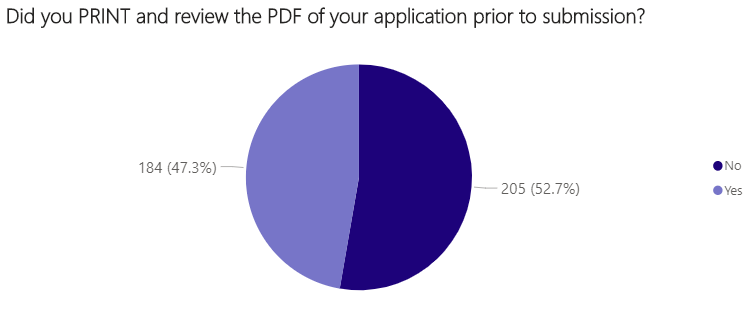
What about trends over time? Since EY 2019 TMDSAS has really amplified the message
that printing the application prior to submission can save applicants from the trouble
of learning about crucial mistakes after it was too late to make any changes.
Applicants seem to have responded in kind by increasingly following the advice to
print their application prior to submission, with the greatest surge seen in EY 2021.
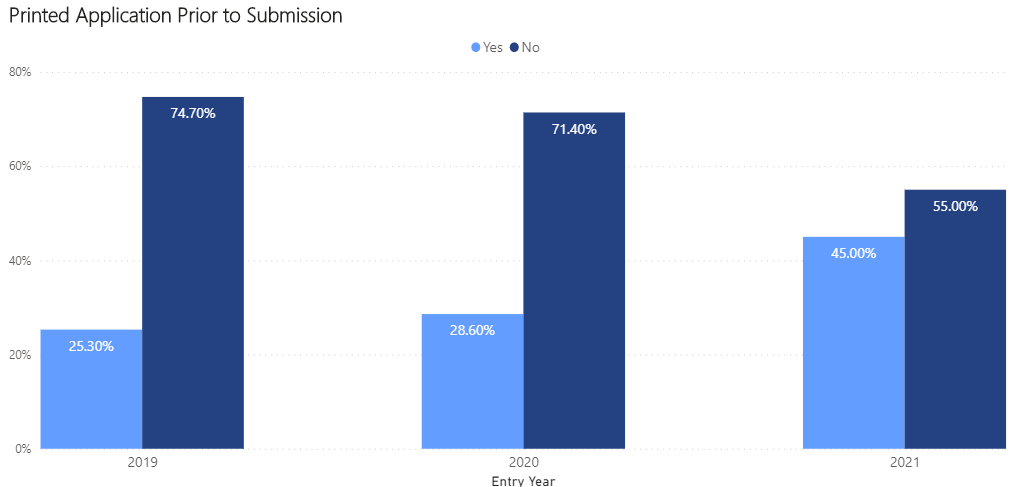
What’s one takeaway here? Repetition is effective, especially when coupled with the
high value proposition of putting forth one’s best application possible.
What does this mean for TMDSAS? When a problem with an application is found during
processing, sometimes the application must be held until the issue is resolved. One
common area in which problems arise is coursework. Here’s a look at how that has changed
over time:

4. Conclusion
The EY 2021 survey taught TMDSAS a lot about applicant behavior, especially with how
applicants prepare for the application.
We see that the most popular activity applicants engage in is meeting with a pre-health
advisor, highlighting the need for TMDSAS to maintain strong relationships with our
advisors, in and out of Texas, and to ensure that they are fully knowledgeable about
us as an application service.
We also learned that applicants from special populations report attending TMDSAS workshops
at a higher rate, so this is a unique opportunity for TMDSAS to build on this resource
by developing webinars with these groups in mind.
At the same time, the survey also revealed that less than half of respondents report
engaging in any kind of pre-application activity at all, so the call to action here
is in creating greater awareness and opportunity for applicants to participate in
these activities prior to completing their TMDSAS application.
The applicant surveys have also shown growth in the awareness and utilization of TMDSAS
resources, such as the Application Guide and Course Listings pages. Applicants are
also indicating that they are taking the time to carefully review their application
prior to submission to ensure thoroughness and accuracy. Both of these gains seem
to coincide with the increased messaging from TMDSAS encouraging applicants to do
so.
Looking Ahead
So what can be expected from TMDSAS as we build towards future application cycles?
- Increase applicant participation in activities designed to prepare them for the application.
- Create targeted application workshops for members of special populations.
- Design Advisor Workshops to better support advisors in this process.
- Ensure application resources are visible, easily accessed, and reflective of the needs
of our applicants.
- Continue broadcasting best practices to applicants and the broader pre-health community.
We know that we can learn a lot from our applicants, and we look forward to more opportunities
to collect feedback and share our findings with the greater pre-health community.

About the author: Nichole A. Castillo is the service delivery coordinator for TMDSAS. She works with the TMDSAS team to educate and prepare applicants prior to the start of the application cycle and coordinates application processing throughout the cycle. Nichole also contributes to the development of resources for applicants and serves as the chief editor of the Application Guide. Additionally, she participates in various outreach efforts, including on-campus or virtual workshops, applicant webinars, and cohosts TMDSAS ‘Office Hours’ via Facebook Live. She is also responsible for coordinating TMDSAS assessments such as the Spring Applicant Survey. Nichole holds a master’s degree in Educational Leadership and Policy studies from UT Arlington and a B.A. from the University of Texas at Austin.
